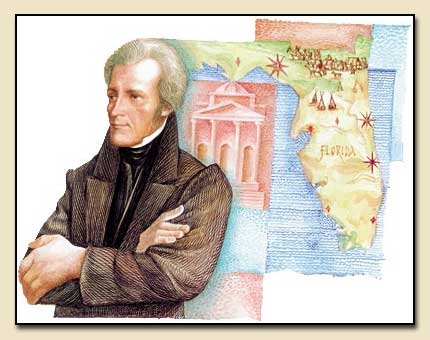|
For protection, the citizens of southern Louisiana looked to Major General
Andrew Jackson, known to his men as "Old Hickory." Jackson arrived in
new Orleans in the late fall of 1814 and quickly prepared defenses along the
city's many avenues of approach.
Meanwhile, the British armada scattered a makeshift American fleet in Lake
Borgne, a shallow arm of the Gulf of Mexico east of New Orleans, and evaluated
their options. Two British officers, disguised as Spanish fishermen, discovered
an unguarded waterway, Bayou Bienvenue, that provided access to the east bank of
the Mississippi River barely nine miles downstream from New Orleans. On December
23 the British vanguard poled its way through a maze of sluggish streams and
traversed marshy land to emerge unchallenged an easy day's march from their
goal.
Two American officers, whose plantations had been commandeered by the British,
informed Jackson that the enemy was at the gates. "Gentlemen, the British
are below, we must fight them tonight," the general declared. He quickly
launched a nighttime surprise attack that, although tactically a draw, gained
valuable time for the outnumbered Americans. Startled by their opponents'
boldness, the British decided to defer their advance toward New Orleans until
all their troops could be brought in from the fleet.
Old Hickory used this time well. He retreated three miles to the Chalmette
Plantation on the banks of the Rodriguez Canal, a wide, dry ditch that marked
the narrowest strip of solid land between the British camps and New Orleans.
Here Jackson built a fortified mud rampart, 3/5 mile long and anchored on its
right by the Mississippi River and on the left by an impassable cypress swamp.
While the Americans dug in, General Pakenham readied his attack plans. On
December 28 the British launched a strong advance that Jackson repulsed with the
help of the Louisiana, an American ship that blasted the British left flank with
broadsides from the river. Four days later Pakenham tried to bombard the
Americans into submission with an artillery barrage, but Jackson's gunners stood
their ground.
The arrival of fresh troops during the first week of January 1815 gave the
British new hope. Pakenham decided to cross the Mississippi downstream with a
strong force and overwhelm Jackson's thin line of defenders on the river bank
opposite the Rodriguez Canal. Once these redcoats were in position to pour flank
fire across the river, heavy columns would assault each flank of the American
line, then pursue the insolent defenders six miles into the heart of New
Orleans. Units carrying fascines -- bundled sticks used to construct
fortifications -- and ladders to bridge the ditch and scale the ramparts would
precede the attack, which would begin at dawn January 8 to take advantage of the
early morning fog.
It was a solid plan in conception, but flawed in execution. The force on the
west bank was delayed crossing the river and did not reach its goal until well
after dawn. Deprived of their misty cover, the main British columns had no
choice but to advance across the open fields toward the Americans, who waited
expectantly behind their mud and cotton-bale barricades. To make matters worse,
the British forgot their ladders and fascines, so they had no easy means to
close with the protected Americans.
Never has a more polyglot army fought under the Stars and Stripes than did
Jackson's force at the Battle of New Orleans. In addition to his regular U.S.
Army units, Jackson counted on dandy New Orleans militia, a sizable contingent
of black former Haitian slaves fighting as free men of color, Kentucky and
Tennessee frontiersmen armed with deadly long rifles and a colorful band of
outlaws led by Jean Lafitte, whose men Jackson had once disdained as
"hellish banditti." This hodgepodge of 4,000 soldiers, crammed behind
narrow fortifications, faced more than twice their number.
Pakenham's assault was doomed from the beginning. His men made perfect targets
as they marched precisely across a quarter mile of open ground. Hardened
veterans of the Peninsular Campaign in Spain fell by the score, including nearly
80 percent of a splendid Scottish Highlander unit that tried to march obliquely
across the American front. Both of Pakenham's senior generals were shot early in
the battle, and the commander himself suffered two wounds before a shell severed
an artery in his leg, killing him in minutes. His successor wisely disobeyed
Pakenham's dying instructions to continue the attack and pulled the British
survivors off the field. More than 2,000 British had been killed or wounded and
several hundred more were captured. The American loss was eight killed and 13
wounded.
Jackson's victory had saved New Orleans, but it came after the war was over. The
Treaty of Ghent, which ended the War of 1812 but resolved none of the issues
that started it, had been signed in Europe weeks before the action on the
Chalmette Plantation.
-A. Wilson Green is the former manager of Chalmette National Historical Park.

|
